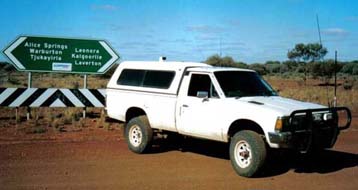
HOME . . . . CAMPING . . . . . TRANSPORT . . . . . HEALTH . . . . . LOCATIONS . . . . . NEWS . . . . . FORUM . . . . . SAFETY
Transport
NEW Some driving tips Serious Four Wheel Drives are clearly the most popular transport in the bush.They are built with high clearance, rugged suspension and generally have a high degree of reliability. A new range of lighter 4X4's have become popular but these are often more suited to weekend excursions and well maintained tracks. I have a personal preference for uncomplicated machinery and try to avoid anything with computer chips and intergrated circuits. This is because I can't fix circuitry and hate the idea that a 50c diode could leave me stranded.
Better electronics and 'fail-safe' circuitry will obviously become more common, but I'm still prepared to have a go at a fix with fencing wire, glue, clamps and such like if the need arises. I feel safer in a well maintained, older vehicle with nothing Hi-Tech on board.
This being said, it is possible to get into most places with a good tradesman's ute, without 4X4. This type of petrol ute is my current ride and you can see its progress by going here: . .Link to forum
Sand and boggy areas will always cause problems, but I will take the same precautions I would even with a four-wheel-drive. I usually look before I commit to water or soft ground.
Sometimes you need to seek high ground and 'camp' to wait-out wet weather even with a 4X4. Local experience is the key in making these descisions and it should be taken early. Trying to drive out of wet country will cut-up the tracks and earn you a bad reputation with pasturalists. Nevertheless, the numbers of battered, semi-wrecked 2X4 utes you will see around in the outback shows that you can get around over most tracks. Just how far 'out' you try and go is the critical factor. Waiting for assistance beside a bogged or broken ute on some tracks could be a very long wait indeed.
My previous mini-truck was a 1984 Datsun 720 series 4X4. It had a 75 litre diesel tank and gaves reliable and economicial performance without being pushed. I tested it for weight during my last trip across the Great Central Road in Central Australia and all-up, it came in as 2700+ Kg when I started out. I found diesel expensive to run while in the city and decided to go back to a small, 1.8lt petrol engine hence, my 1979 tradesmans ute.
This is my gear list evan though I now have the ute: A total of 100 lts of gas; 120 lts of water (1 x 80 lt tank, 2x 20 lt jugs ), Tool boxes x 3, recovery gear ; snatch straps, chains, two hand winches, lots of ropes; 10 lts engine oil and various filter sets, gear and diff oils. Spare water pump, engine belts, repair materials inc: epoxy glues, epoxy putty (steel and plastic) "No-more-nails" a brilliant general purpose hole filler and strong repair glue. Four sets of spare rims and tyres with repair plugs and fizz cans; proper patches and a set of inner-tubes x 2. Various O-rings, gasket papers and silicon sealants, tie-wire and clamps for general fixes as well as exhaust repair. A full electricial repair kit with spare wire and fuzible links etc. Many other items are carried with an eye towards 'make-do' repairs to just about anything.
It is imposible to cover yourself against unknown events entirely so, a good range of radio's are very handy. UHF and CB. CB is good because I could probably get in touch with an Idaho potato farmer using 'skip' and get them to make a call for me . . . LOL
Here are a few links . . .Expanded gear list
. . . . . . . . . . . . . . . . .s
Here's a link to a good travel site: http://www.4x4web.com.au/skips4x4/
HOME . . . . CAMPING . . . . . TRANSPORT . . . . . HEALTH . . . . . LOCATIONS . . . . . NEWS . . . . . FORUM . . . . . SAFETY